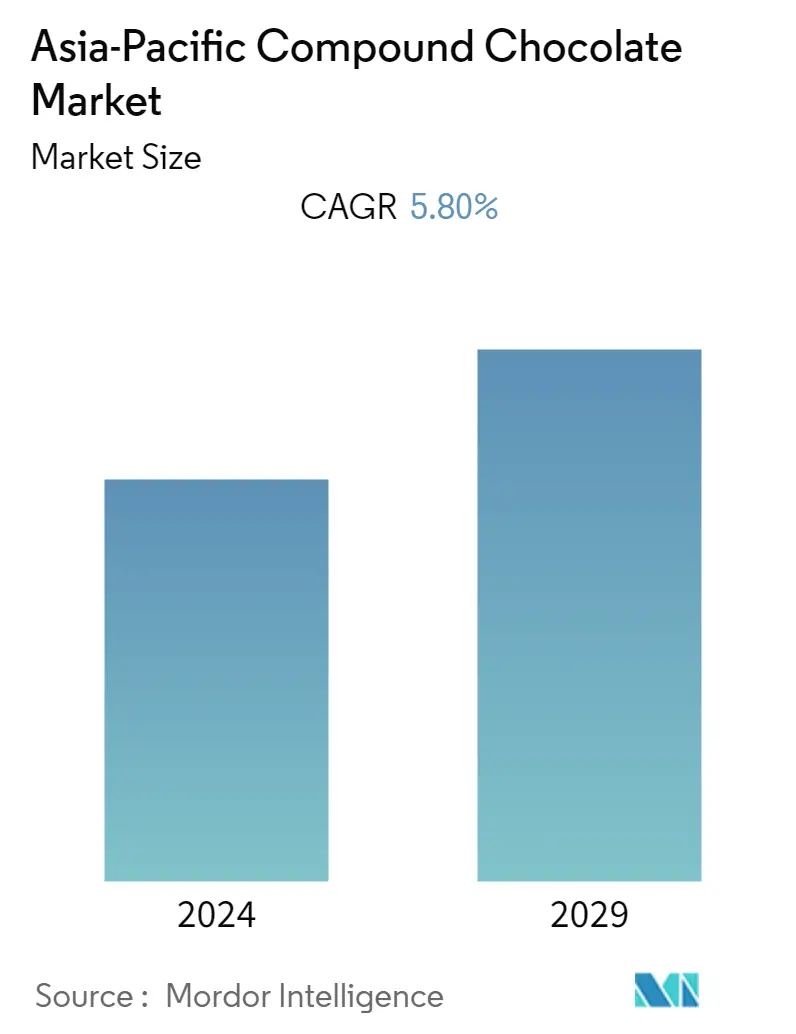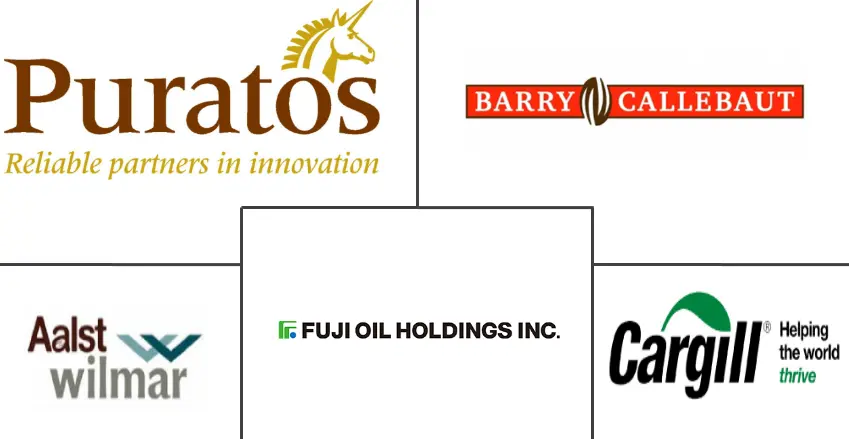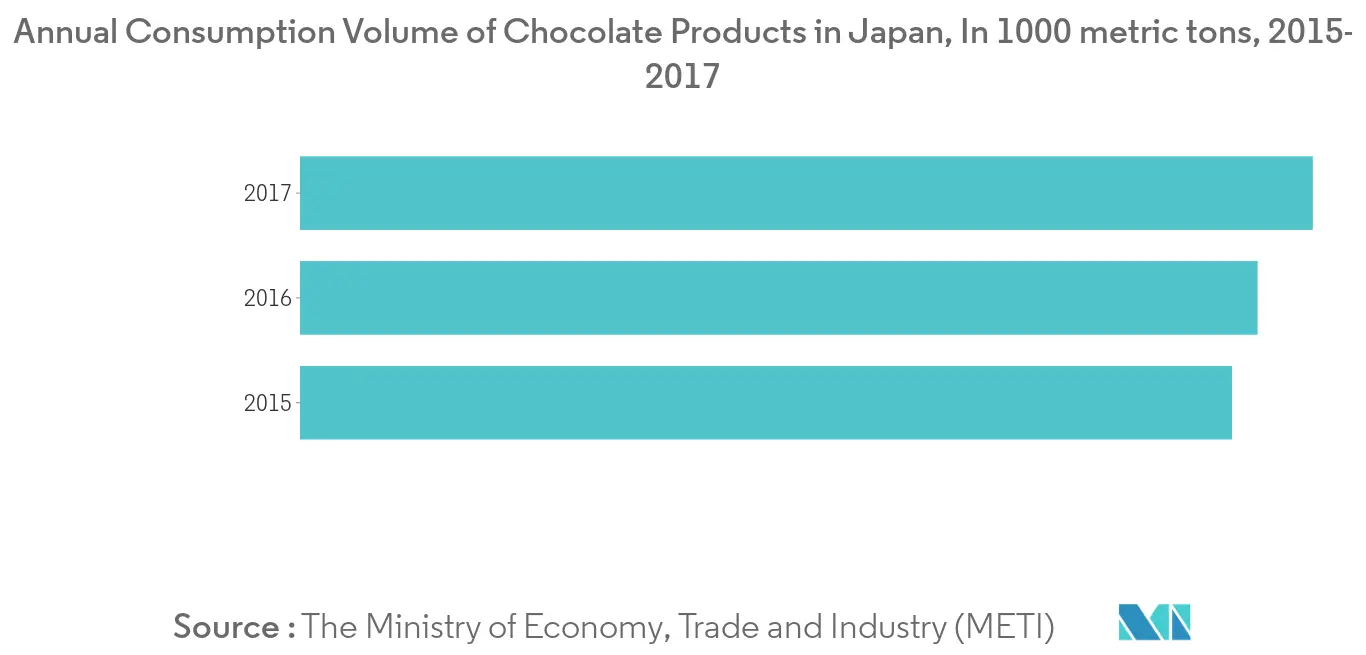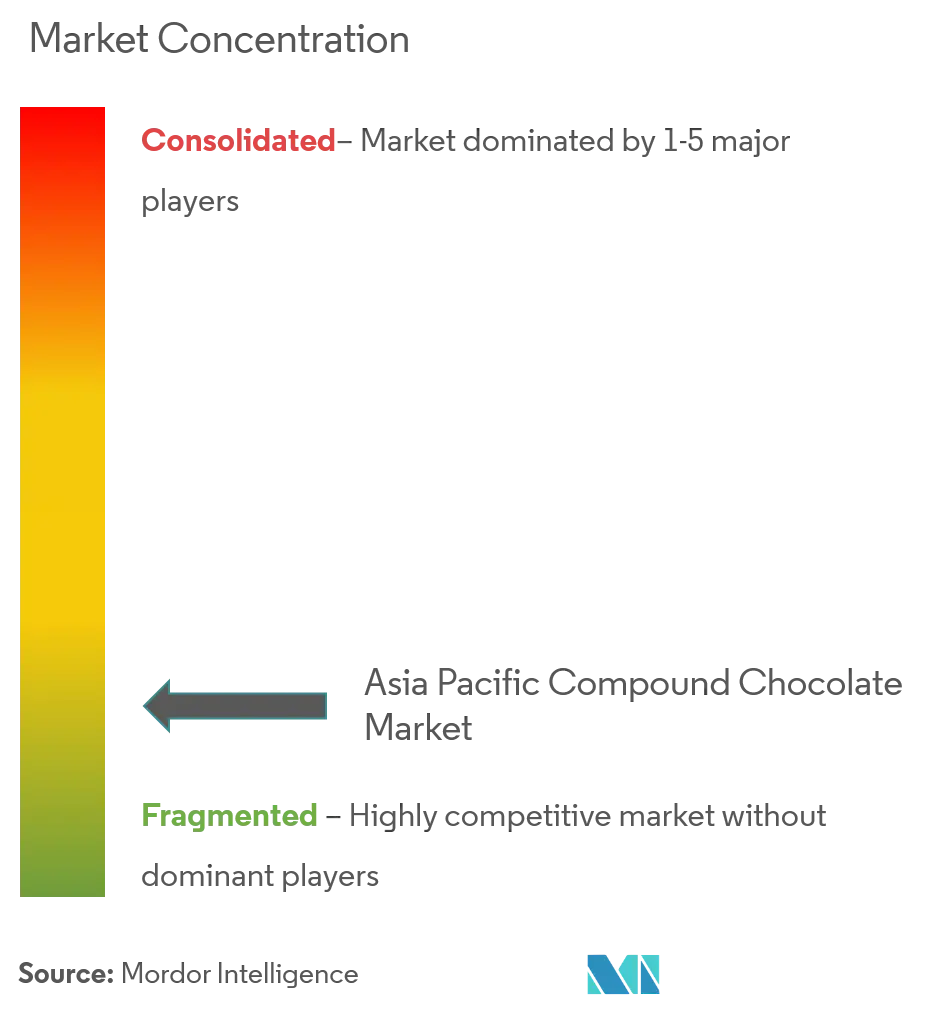Asia Pacific Compound Chocolate Market Size

| Study Period | 2019 - 2029 |
| Base Year For Estimation | 2023 |
| Forecast Data Period | 2024 - 2029 |
| Historical Data Period | 2019 - 2022 |
| CAGR | 5.80 % |
| Market Concentration | Low |
Major Players
*Disclaimer: Major Players sorted in no particular order |
Asia Pacific Compound Chocolate Market Analysis
The Asia-Pacific compound chocolate market is projected to grow at a CAGR of 5.8% during the forecast period.
- The primary factor driving the market for compound chocolates is the robust demand for the product from the expanding food and beverage industry in the country for various applications, such as bakery, confectionery, frozen dessert, ice cream, beverages, cereals, and others.
- In addition, the bakery industry in the country is also emerging as the lucrative application sector amid the growth of artisanal baked commodities, thereby, aiding the growth and demand for compound chocolates.
Asia Pacific Compound Chocolate Market Trends
This section covers the major market trends shaping the APAC Compound Chocolate Market according to our research experts:
Growing Demand for Chocolate Confectionery
Despite rising concerns around sugar intake, consumers continue to demand every day and more indulgent treats and snacks. Premiumization of the market has been indicated by the growing use of dark chocolate, but the choice of dark, milk or white is now being broken down with the arrival of dark milk choices, offering a half-way point between rich dark and smooth milk recipes. Although chocolate confectionery consumers do not traditionally tend to have high levels of concern about health issues, the rising awareness of the need to reduce sugar intake does seem to be starting to influence new product development.

Increased Utilization in Bakery
Compound chocolate is the most commonly used chocolate in the baking industry today. Moreover, the main consumption trends within the bakery continue to be focused around concerns over healthy eating, the need for convenience, and the desire for variety. Therefore, compound chocolate provides the following characteristics needed by consumers. The shelf life of fresh baked goods enrobed with compound coating does not get affected because hard fat is used to adjust the melting point and carries enough seed to make necessary tempering. Since there is no cocoa butter (generally) present in compound chocolate, it offers cost savings, and it eliminates the time needed in tempering.

Asia Pacific Compound Chocolate Industry Overview
Asia-Pacific compound chocolate market is fragmented with the presence of several players competing for the market share. The major players in the market are focusing on new product launches, expansion, mergers and acquisitions and partnerships to gain a competitive advantage in the market and therefore strengthening their hold in the market. The key players in the market are Cargill, Puratos, The Barry Callebaut Group, and Fuji Oil Holding Inc among others.
Asia Pacific Compound Chocolate Market Leaders
-
Cargill Incorporated
-
Puratos
-
The Barry Callebaut Group
-
Aalst Wilmar Pte Ltd
-
Fuji Oil Holding Inc
*Disclaimer: Major Players sorted in no particular order

Asia Pacific Compound Chocolate Market Report - Table of Contents
1. INTRODUCTION
- 1.1 Study Assumptions & Market Definition
- 1.2 Scope of the Study
2. RESEARCH METHODOLOGY
3. EXECUTIVE SUMMARY
- 3.1 Market Overview
4. MARKET DYNAMICS
- 4.1 Market Drivers
- 4.2 Market Restraints
-
4.3 Porter's Five Forces Analysis
- 4.3.1 Threat of New Entrants
- 4.3.2 Bargaining Power of Buyers/Consumers
- 4.3.3 Bargaining Power of Suppliers
- 4.3.4 Threat of Substitute Products
- 4.3.5 Intensity of Competitive Rivalry
5. MARKET SEGMENTATION
-
5.1 By Type
- 5.1.1 Dark Chocolate
- 5.1.2 Milk Chocolate
- 5.1.3 White Chocolate
-
5.2 By Form
- 5.2.1 Chocolate Chips/Drops/Chunk
- 5.2.2 Chocolate Slab
- 5.2.3 Chocolate Coatings
- 5.2.4 Other Products
-
5.3 By Application
- 5.3.1 Bakery
- 5.3.2 Confectionery
- 5.3.3 Frozen Desserts and Ice-Cream
- 5.3.4 Beverages
- 5.3.5 Cereals
- 5.3.6 Others
-
5.4 Geography
- 5.4.1 Asia Pacific
- 5.4.1.1 China
- 5.4.1.2 Japan
- 5.4.1.3 India
- 5.4.1.4 Australia
- 5.4.1.5 Rest of Asia-Pacific
6. COMPETITIVE LANDSCAPE
- 6.1 Most Active Companies
- 6.2 Most Adopted Strategies
- 6.3 Market Share Analysis
-
6.4 Company Profiles
- 6.4.1 Cargill, Incorporated
- 6.4.2 Puratos
- 6.4.3 The Barry Callebaut Group
- 6.4.4 Aalst Wilmar Pte Ltd
- 6.4.5 Fuji Oil Holding Inc
- 6.4.6 KCG Corporation
- 6.4.7 Unigra
- 6.4.8 The Bühler Holding AG
- *List Not Exhaustive
7. MARKET OPPORTUNITIES AND FUTURE TRENDS
** Subject To AvailablityAsia Pacific Compound Chocolate Industry Segmentation
The Asia-Pacific chocolate market is segmented by type that includes dark chocolate, milk chocolate, and white chocolate. Based on form, the market is divided into chocolate chips/drops/chunks, chocolate slab, chocolate coatings, and other products. By application, the market is classified into the bakery, confectionery, frozen desserts, and ice-cream, beverages, cereals, and others. The study also involves the analysis of regions such as China, Japan, India, Australia and the rest of Asia-Pacific.
| By Type | Dark Chocolate | |
| Milk Chocolate | ||
| White Chocolate | ||
| By Form | Chocolate Chips/Drops/Chunk | |
| Chocolate Slab | ||
| Chocolate Coatings | ||
| Other Products | ||
| By Application | Bakery | |
| Confectionery | ||
| Frozen Desserts and Ice-Cream | ||
| Beverages | ||
| Cereals | ||
| Others | ||
| Geography | Asia Pacific | China |
| Japan | ||
| India | ||
| Australia | ||
| Rest of Asia-Pacific |
Asia Pacific Compound Chocolate Market Research FAQs
What is the current Asia-Pacific Compound Chocolate Market size?
The Asia-Pacific Compound Chocolate Market is projected to register a CAGR of 5.80% during the forecast period (2024-2029)
Who are the key players in Asia-Pacific Compound Chocolate Market?
Cargill Incorporated, Puratos, The Barry Callebaut Group, Aalst Wilmar Pte Ltd and Fuji Oil Holding Inc are the major companies operating in the Asia-Pacific Compound Chocolate Market.
What years does this Asia-Pacific Compound Chocolate Market cover?
The report covers the Asia-Pacific Compound Chocolate Market historical market size for years: 2019, 2020, 2021, 2022 and 2023. The report also forecasts the Asia-Pacific Compound Chocolate Market size for years: 2024, 2025, 2026, 2027, 2028 and 2029.
Asia Pacific Compound Chocolate Industry Report
Statistics for the 2024 Asia Pacific Compound Chocolate market share, size and revenue growth rate, created by Mordor Intelligence™ Industry Reports. Asia Pacific Compound Chocolate analysis includes a market forecast outlook 2029 and historical overview. Get a sample of this industry analysis as a free report PDF download.



